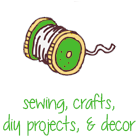Layered paint can give pieces such a fun antiqued effect. It's one of my favorite techniques to transform furniture.
When I'm ready to tackle a new piece of furniture, I have a mental rolodex of paint techniques I go through before deciding on the *perfect* finish. I have to say, this is one of my favorites that I use time and time again. Layered paint: see the complete tutorial below>>>
When I obtained this funky little foot stool at a booth in Round Top, Texas, I wasn't 100% sure what it would end up looking like. And have you ever been to the funky-junky time that is Round Top twice a year? Amazing. Like, really. I also scored a couple of old grain sacks at Round Top, and used a portion of one of them for the top part of this. The bottom portion was finished with this easy technique for layered paint to get that perfect old look.

This particular piece already had a few layers of paint on it to begin with...which made it a bit easier on me. But, below, I'm using a scrap board to show you step by step how you can achieve this same look.
The top couple of layers on this piece are Miss Mustard Seed's Eulalie's Sky Milk Paint along with a beeswax puck {I have substituted a taper candle for this before with no problem, if you don't have a beeswax puck}, and furniture wax {also from Miss Mustard Seed}. I use the little whippy tool to mix my milk paint up.
I was super excited to take a class from the one and only Miss Mustard Seed {Marian } when I was up in Utah at the Snap Conference last spring. It was awesome to learn from the creator herself! She was every bit as amazing in person as she is on her blog!
This may seem complicated...but it's just a few steps that all come together for a super fun layered paint finish.
1. I started by painted the base of the piece with a neutral colored chalk paint. I like ASCP in Country Grey but anything you like will work. The reason I use chalk paint for the base is because it adheres to practically anything without a lot of prep work involved. Once you get several layers away from the base coat and are starting to sand away layers, the chalk paint is nice and "stuck" and not as likely to be sanded off as easily.
2. After my base coat of chalk paint is dry, I used my beeswax puck to go along the edges. The wax helps the next few layers of paint not to adhere as well...making them easier to pull off with sand paper. Again, if you don't have the beeswax, you can also use a taper candle for a similar effect.
3. I added a dark layer of chalk paint on next. In the areas where I did not apply the wax, this next layer of chalk paint should stick fairly well. I do this in order to have different colors showing through in different areas of the piece.
4. On the edges, I just used a can of spray paint to add another color to the mix. There was no rhyme or reason to this. If you want to, you can also add beeswax between each layer of paint...it's fun to just play with it and see what works best for your style.
5. Next, I add on my Milk Paint. Milk Paint is interesting because you can't always predict how it will react with a piece you're working with. It may be chippy or it may look completely normal...I think that's why I like it so much! It's always a fun surprise. I purposely added it on a little "rough" and sloppy...I knew I could sand some of the rough spots out later. But I wanted a layery look, so the rough application really worked for me.
6. I used a 150 grit sand paper to start sanding off layers of paint until I really like the result. You can sand as much or as little as you like. I always start on the edges...the natural places a piece is weathered. Then I work my way to the middle areas and keep sanding until I just love it!

Above is the finished board. Below are a couple of extra steps I added in, specifically for the foot stool. You can add them or just leave your piece like the one above.

After sanding and then removing all of the saw dust, I added stain to the areas that were sanded off. I work them in and then can "pull" them off if they're too dark, before they're completely dry. The stain just deepens and darkens the weathering.

In order to seal the piece, I use a dab of furniture wax on all areas of it. There's so many options with waxing. I just used the neutral colored wax on this piece, but a dark wax could have aged it further or a white wax can age it in a completely different manner. I just use a soft cloth and work the wax into the piece. If there's too much wax on the piece, add more to pull it off {sounds counter-intuitive, but it works like a charm}.

So, what do you think? Is this layered paint technique something you're familiar with or would like to try?















Beautiful makeover! Love that color.
ReplyDeletePinned and shared on Facebook and Twitter. Much needed tutorial on this method. Thanks, oh, and hope your 2016 is wonderful - healthy, happy... your friend at Crafts a la mode
ReplyDeleteI love this Kristi!! So beautiful!! Thanks for sharing it with us at Work it Wednesday- I'm featuring you tomorrow:)
ReplyDelete